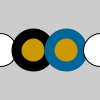pop_style()#
The push_style() function saves the current style settings and pop_style() restores the prior settings; these functions are always used together.
Examples#

def setup():
py5.ellipse(0, 50, 33, 33) # left circle
py5.push_style() # start a new style
py5.stroke_weight(10)
py5.fill(204, 153, 0)
py5.ellipse(50, 50, 33, 33) # middle circle
py5.pop_style() # restore original style
py5.ellipse(100, 50, 33, 33) # right circle

def setup():
py5.ellipse(0, 50, 33, 33) # left circle
py5.push_style() # start a new style
py5.stroke_weight(10)
py5.fill(204, 153, 0)
py5.ellipse(33, 50, 33, 33) # left-middle circle
py5.push_style() # start another new style
py5.stroke(0, 102, 153)
py5.ellipse(66, 50, 33, 33) # right-middle circle
py5.pop_style() # restore the previous style
py5.pop_style() # restore original style
py5.ellipse(100, 50, 33, 33) # right circle
Description#
The push_style() function saves the current style settings and pop_style() restores the prior settings; these functions are always used together. They allow you to change the style settings and later return to what you had. When a new style is started with push_style(), it builds on the current style information. The push_style() and pop_style() method pairs can be nested to provide more control (see the second example for a demonstration.)
Underlying Processing method: popStyle
Signatures#
pop_style() -> None
Updated on March 06, 2023 02:49:26am UTC
